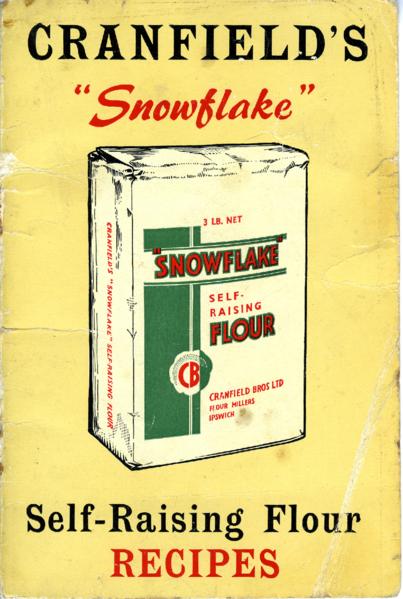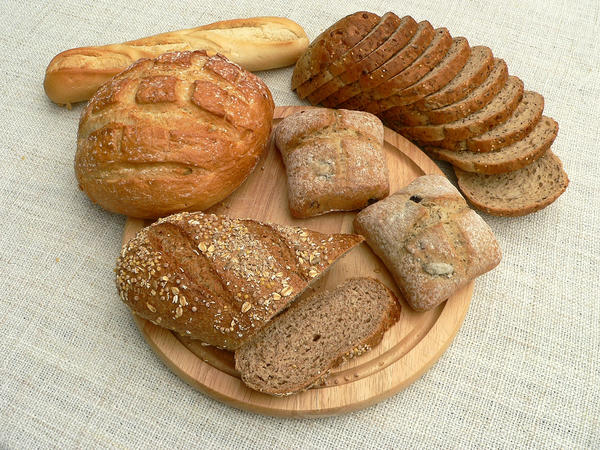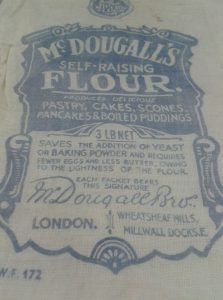From Mill to Shelf: Final Product
Once the milling process is completed you are left with the final product, flour. However, just as there are different varieties of wheat, so there are many different types of flour:
Wholemeal, Brown and White Flour
The difference between white, brown and wholemeal flour is caused by the different amounts of the grain that is in the flour. As can be read in the milling process section, white flour is made out of the endosperm, with the bran and germ extracted. However, it is possible to make flour that includes the bran and the germ. Either some can be retained, which makes brown flour, or the whole grain can be used with nothing added or taken away, which makes wholemeal flour.
The natural nutrients in wheat can be found in the germ and bran so this means that wholemeal flour is more nutritious and higher in fibre than white flour, which only contains the endosperm. In taste, wholemeal flour is nuttier whilst it also has a darker colour than white flour. For some, the difference in taste and colour makes it an unappealing option whilst others prefer the nutritious benefits they can gain from it. Debate has surrounded the merits of the two different types of flour and bread for years, since 1880 in fact with the founding of the Bread Reform League and their ‘campaign against white bread’ (Jones, p.119). Today there is a market for both types of flour and bread benefitting the milling industry.
As the difference in this type of flour comes from the milling process, rather than the wheat, all the following types of flour can be found in both wholemeal and white varieties:
Plain Flour

Plain flour is made out of soft wheats so has a low gluten content. This makes it the best suited flour for making products that have a more crumbly texture, such as biscuits, scones, and pastries.
Self-Raising Flour
Self-raising flour is often made from a mixture of soft and hard wheats. A raising agent is added during its manufacture, usually baking powder or bicarbonate of soda, meaning it can give a rise to bakes without extra rising agent needing to be added. This makes it good for making cakes
Strong Flour
As can be read about in the raw product section, hard wheat has a higher level of gluten meaning dough is given a greater elasticity and rise. This means that strong flour is needed when making bread.

Depending upon whether the flour is white or wholemeal will affect the colour of the bread once cooked. This plays a very important role and is arguably partly responsible for roller milling evolving:
‘The colour of flour is a most important character owing to the insistent demand of the majority of the British public for bread that shall be as nearly white as is technically possible. A pure white flour is probably impossible as a commercial proposition, but the more closely the colour approximates to white the more easily can the flour be sold.’ (Fisher, pp.10-11)
If it were not for this insistence of the public to have white bread, a more efficient way to mill white flour may not have been looked for and roller milling may never have developed.
Durum/Pasta Flour
Pasta requires a very particular flour to be made. This comes from durum wheat and it makes very strong durum/pasta flour. This makes a dough with a firm texture but it is able to be rolled very thinly within losing its structure. This is why this particular flour is used for this product.
Packing and Storage

Once these different types of flour have been made within the mill, it then becomes necessary to store the flour and package it ready for transport. According to Kick, ‘Flour is either packed in sacks or casks; in the former only for transport over short distances, in the latter for long distances or for storage, casks being a better protection from damp than sacks’ (Kick, p.247). The main issue with storing and packing and flour then, was the protection from damp. This meant there were three practical ways to store the flour:
- By loosely shovelling it into large receptacles or rooms to a depth of not more than 1.58m (5’) freely exposed to the air, and frequently turned over.
- By loosely packing in sacks.
- By compressing it in sacks or casks. (Kick, p.248)
He advises the first or second method for general use as they allow the moisture in the flour to escape. However, when transporting it long distances, the third method of compressing it in barrels is best. Then the flour could be kept safely, damp kept out and moisture allowed to escape.
However, this did not mean that flour, or the workers, were safe from all harm as The Miller reported on 4 March 1889:
‘While some men were storing flour on the top flat of a warehouse at Greenock on the 20th ult., part of the east wall fell out, the floor and beams, with several hundred bags of flour, falling on the floor beneath, breaking the beams and smashing through to the ground floor. A number of men were at work in the store at the time, and there were many narrow escapes. Five men were buried in the debris and were with difficulty extricated. They were conveyed to the infirmary, one of them being dangerously injured.’ (‘Accident’, The Miller, (March 4, 1889), p.28.)
So even once the flour had been ground and the milling process was completed, the dangers of the mill site were not over and accidents could still take place.
Once the flour had been packaged, it was ready to be sold and transported away from the mill.
Sources:
‘Accident’, The Miller, (March 4, 1889), p.28.
Fisher, E. A., Flour Quality: its Nature and Control (London, 1929).
www.bbc.co.uk/food/flour accessed on 25.09.2017.
https://www.botham.co.uk/bread/mill2.htm accessed on 23.09.2017.
https://www.dovesfarm.co.uk/hints-tips/types-of-flour accessed on 25.09.2017.
Kick, Friedrich, Flour Manufacture: A Treatise on Milling Science and Practice (London, 1888).
